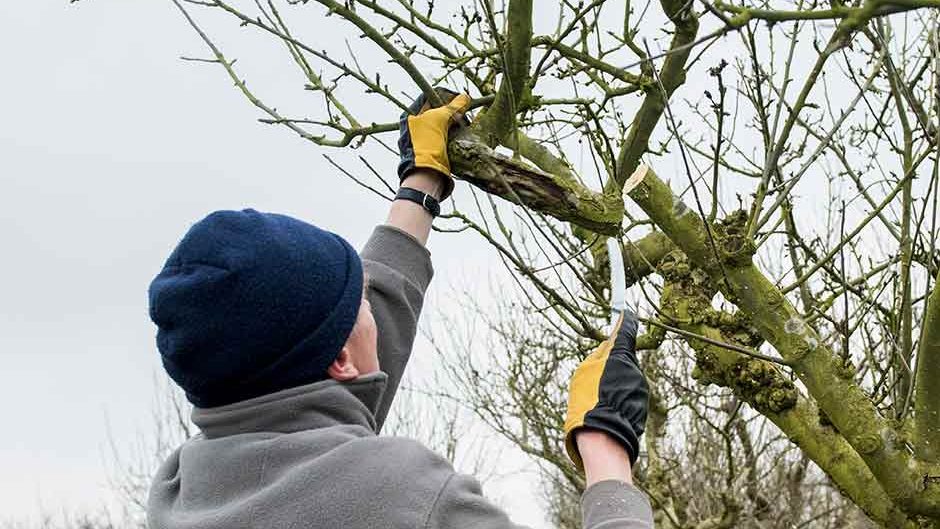
DISCOVER THE PLANTS THAT SHOULD BE PRUNED IN WINTER…
Many trees and garden plants benefit from pruning, and a great time to prune in winter. Before you begin, it’s useful to consult a sharpening guide to ensure your tools are in optimal condition. They become dormant as a result of seasonal changes in temperature and outdoor conditions and once the leaves have fallen it’s easier to see a plant’s framework. But it’s important to prune at the right time of the year and in the right way.
The aim of winter pruning is to encourage healthy growth, cutting and reshaping so that fruit trees remain productive and shrubs don’t overgrow their space. Winter is the time to prune your roses, cut back clematis and reshape fruit bushes and trees. It’s also a time to revive plants that can become large and unproductive, such as viburnum and mahonia. Another benefit to pruning in winter is to help control or prevent the spread of disease.
Secateurs, loppers, folding pruning saws and pruning handsaws will enable you to tackle a wide variety of jobs. Remember, maintain these tools effectively with a comprehensive guide on sharpening.
REMEMBER THOUGH… Not all plants are suitable for winter pruning. Some plants should be pruned in spring, while others are best left until summer or autumn. Check out our ‘what to prune in’ guides for other seasons. Consult a sharpening guide for more detailed information on tool maintenance through the seasons.
Fruit Trees – Apple and Pears
Apples and pear trees should be pruned from November to mid-March to encourage fruiting. Pruning will help encourage a good crop by enhancing energy into the remaining buds. Aim to create a wine-glass shape, with evenly spaced branches rising up from the trunk in a circle around a hollow centre. Cut off any shoots at the base and remove dead, diseased or crossing branches.
Do not prune stone fruits, such as cherries or plums, in winter as they risk being infected by a fungal disease called silver leaf. Prune them in early or mid-summer instead. Using a detailed guide for sharpening regularly will ensure your pruning work is accurate and clean.
Roses
Cut back bush and climbing roses hard in late winter to promote healthy growth, flowering shoots and plenty of blooms in the summer. Many types of roses can be pruned in winter, including floribundas, hybrid teas, shrub trees and climbing roses. Rambling roses should be pruned in late summer, but can be renovated in winter. As a general rule, cut back thin, weak stems the most, and thick, vigorous stems the least. Aim to leave plants anything from 15cm to 45cm tall, depending on the original size of the plant and your preference.
Shrubs
Deciduous shrubs should be pruned in winter, particularly those that grow too big for their allocated space. Renovation pruning will revive plants that can become large and unproductive, such as cotinus, berberis, flowering currants and magnolias. A sharpening guide is an invaluable tool in keeping your pruning precise.
Fruit Bushes
Fruit bushes, including blueberries and blackcurrants, gooseberries and redcurrants, should be pruned in winter. As a general rule, remove some old wood each year, creating a goblet shape, leaving healthy young branches that will produce large crops in years to come.
Grapevines
Grapevines are woody, deciduous plants that ooze sap, or ‘bleed’ when they’re pruned. If cut stems bleed, it can weaken the plant, so it’s important to prune them in mid-winter, when they’re deeply dormant. Other plants that bleed when pruned include acers, birches, and figs. Prune in December or January, by cutting back to a main ‘rod’, or arm, that’s trained out vertically along support wires.
Wisteria
Wisteria should be pruned twice a year, in December and again in summer, to keep it in check and promote flowering. In winter, prune all side-shoots back to three or four buds. Then, after summer flowering, cut back all whippy shoots to 30cm, depending on the original size of the plant and your preference.
Ornamental Trees
From November to March, remove smaller branches from ornamental trees to create a clean, bare stem at least 90-120cm tall. Remove branches that impede access or block mowing, but cut sensitively, thinning out rather than chopping back the whole canopy. A comprehensive guide to sharpening ensures your tools remain effective for such sensitive pruning.
Clematis
There are varying categories of Clematis. Group 3 clematis flowers in mid-late summer and requires pruning in February. Prune in February by cutting the plant down to 10cm above the ground to remove long, old growth and encourage strong flowering shoots. Cut back Texensis and viticella hybrids to ground level before new growth emerges. Most other groups of clematis only need a light tidy up after flowering.
This guide is intended to give information and advice only. It is the user’s responsibility to ensure necessary training and experience is achieved to use a pair of secateurs and pruning tools safely.
